

Media Literacy in Early Childhood Report. Young children are regularly engaging with media in their homes, schools, and outside of school experiences including museums and libraries.

All of these environments offer an opportunity to support and develop young children’s media literacy skills. However, there is a lack of consensus about what media literacy education for young children means and includes, what media literacy experiences in both informal and formal early childhood settings should look like, and how to empower parents and other adults as media literacy role models and mentors. The Media Literacy in Early Childhood Report is a result of needing a consensus view of media literacy in an early childhood framework.
The intention of this report is to utilize media literacy, child development, and early education efforts to propel media literacy in early childhood efforts by developing education materials and advocating for support at micro-, meso-, and macro-level impacts of a young child’s life. Documents: Authors Alexis R. 12 Excellent Physics Apps for High School Students. July 14, 2017 Here is a collection of some good educational iPad apps to help you with the teaching/learning of physics.
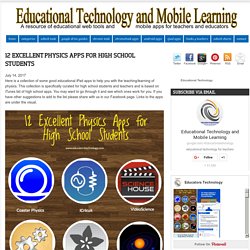
This collection is specifically curated for high school students and teachers and is based on iTunes list of high school apps. You may want to go through it and see which ones work for you. If you have other suggestions to add to the list please share with us in our Facebook page. Links to the apps are under the visual. 100 Websites That Rule The World. By Ayana|source: HereJul 14th, 2017 I don’t know much about you, dear reader, but since you’re reading this, I can assume we have this in common: We’re both regular website users and infographic viewers.
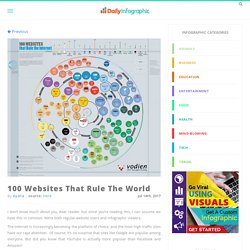
The internet is increasingly becoming the platform of choice, and the most high traffic sites have our rapt attention. Of course, it’s no surprise that sites like Google are popular among everyone. But did you know that YouTube is actually more popular than Facebook and Amazon? This infographic shows the top 100 websites around the world. It’s likely that you’ll see some sites you don’t frequent on the list, as they span a number of categories.
I’ve definitely picked up a few ideas for sites to check out thanks to this post. We know the most popular websites in the world, but where in the world are people accessing the Internet? Ayana Lage graduated from the University of Florida with a journalism degree and a minor in communication studies. 2.5k. Best Databases: Watch science spring into action with these must-have resources. With more and more librarians scaling back on encyclopedias and thinking twice before investing in expensive multivolume sets, selecting the right database has become more vital than ever.
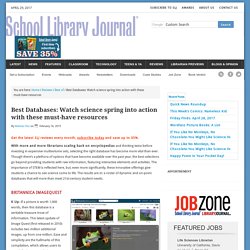
Though there’s a plethora of options that have become available over the past year, the best selections go beyond providing students with raw information, featuring interactive elements and activities. The importance of STEM is reflected here, but, even more significantly, these innovative offerings give students a chance to see science come to life. The results are in: a roster of dynamic and on-point databases that will more than meet 21st-century student needs. Britannica ImageQuest K Up–If a picture is worth 1,000 words, then this database is a veritable treasure trove of information.
ProQuest Research Companion Rosen “Core Concepts”: Biology; Chemistry Gr 6 Up–Rosen’s “Core Concepts” products have long been valuable resources, and these latest additions are no exception. Perceptions 2016: An International Survey of Library Automation. This tenth edition of the International Survey of Library Automation aims to provide a candid glimpse into the effectiveness of strategic library technology systems from the perspective of the libraries which use them for their daily operations and to fulfill the expectations of their patrons.
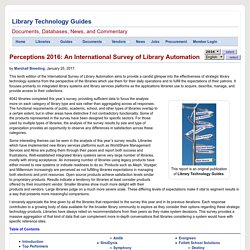
It focuses primarily on integrated library systems and library services platforms as the applications libraries use to acquire, describe, manage, and provide access to their collections. 4042 libraries completed this year’s survey, providing sufficient data to focus the analysis more on each category of library type and size rather than aggregating across all responses. The functional requirements of public, academic, school, and other types of libraries overlap to a certain extent, but in other areas have distinctive if not contradictory functionality. Some of the products represented in the survey have been designed for specific sectors. Table of Contents Introduction top Caveats Survey Results Alma.
YouTube Video Converter - Convert to MP3, MP4, AVI, MKV. 8 Design Steps for an Academic Makerspace. Hands-on Learning 8 Design Steps for an Academic Makerspace If you build it, will they come?

The 8 Digital Literacy Practices Required for 21st Century Learners. January 4, 2015 Theoretically speaking, digital literacy is a concept that is in constant flux.
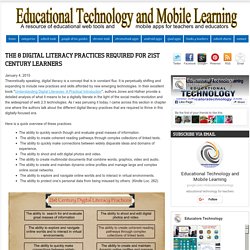
It is perpetually shifting and expanding to include new practices and skills afforded by new emerging technologies. In their excellent book "Understanding Digital Literacies: A Practical Introduction", authors Jones and Hafner provide a detailed analysis of what it means to be a digitally literate in the light of the social media revolution and the widespread of web 2.0 technologies. As I was perusing it today, I came across this section in chapter one where the authors talk about the different digital literacy practices that are required to thrive in this digitally-focused era. What Does the Next-Generation School Library Look Like? At a time when public libraries are starting to offer everything from community gardening plots to opportunities to check out humans for conversations, some school libraries are similarly re-evaluating their roles and expanding their offerings.
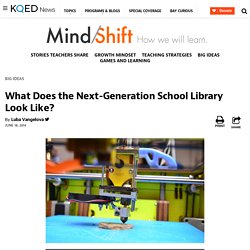
Case in point: Monticello High School in Charlottesville, Virginia. When librarian Joan Ackroyd arrived there four years ago, she found an environment very different from the “engaging, creative, fun” elementary and middle school libraries to which she was accustomed. “Its library was none of those things,” she recalls. “It was a traditional, quiet research space.” Ackroyd decided this wasn’t optimal. As her first step, she and her co-librarian at the time (music teacher Dave Glover), converted a storeroom into a technology lab. Teachers balked because the library was no longer quiet, but students liked it, and many at-risk students became frequent visitors.
Technology Teach Library - Blog.